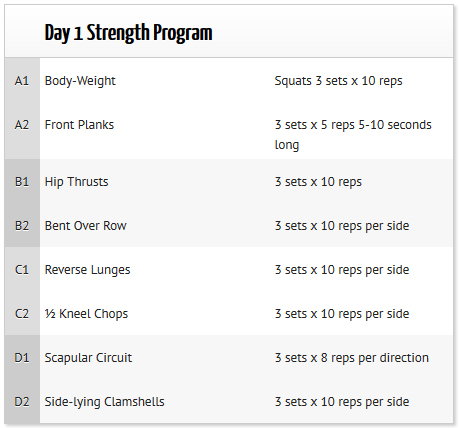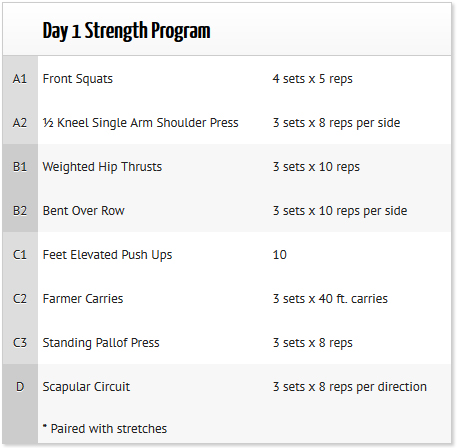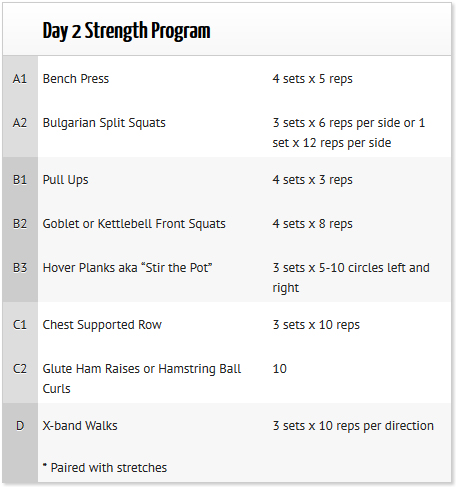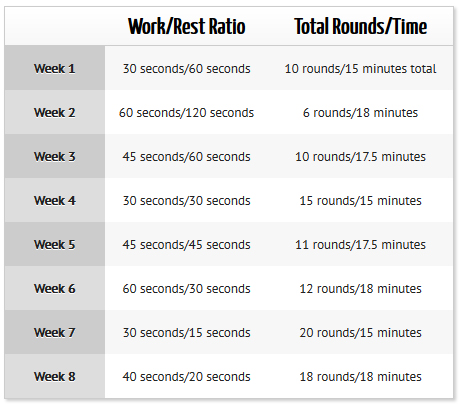FACT: The more your strength train, the more you’ll enjoy it and the results.
If you don’t strength train, I highly recommend that you read THIS post to help you better understand why strength training is important, and why your should consider incorporating it into your fitness program.
If you are currently strength training, but aren’t happy with the results—perhaps your progress is at a standstill due to time constraints, injury, plateaus or all three—then I encourage you to read THIS post and learn why you’re not getting stronger.
Before you can even consider training—of any kind—you need to take a long and hard look at yourself. You are the key to your own success, and thus the foundation of your strength training blueprint is you. Meaning, YOU must be willing to take action if you want to see results.
Once you have decide to commit to yourself and take action, it is then time to figure out your fitness level. There are a number of different levels of fitness, and it’s important that you are training on the level that is appropriate to you. To help you figure yours out I have broken down this article into the following three categories—
- The beginner
- The novice
- The advanced
I have outlined the details of each training level below. But if you’re still not sure which level best suites you after you finish reading this article, please don’t hesitate to reach out to me directly at andrea@balancemotion.com, or come visit me at the Balance In Motion studio. I along with one of our other trainers would be happy to help you figure it out.
With that, let’s dive right in.
The Beginner
This applies to you if— you are completely new to strength training or have taken a hiatus.
If you’re new to strength training, I strongly recommend that you seek assistance prior to starting your training regime to ensure that you don’t have any functional limitations or compensation patterns that may haunt you down the line. If you are starting from scratch, this is a great time to address postural imbalances and restrictions—it’s way harder to take a break to regress your program once you’re going full steam.
Week 1-6 – Build up your foundation
During your first 6-weeks of training understand that the strength gains that you achieve are as a result of adaptations within your central nervous system. Translation: during this time you will not see too much of an increase to the size of your muscles. So start by getting out of the mindset that you need to focus on a lot of weight or complexity with your training to see results.
During this phase your body is simply learning how to deal with the new stressors you are introducing on a inter-muscular (weeks 1-3) and intra-muscular (weeks 4-6) level. Essentially your muscles are learning how to communicate with each other to produce movement. The best thing you can do during the first 6-weeks of starting your strength program is to instil good practice with perfect technique—which will ultimately pave the way to a good lifting career.
What to focus on—
- Basic core activation and glute activation
- Foundational movements – below are the key movement patterns you want to focus on
Lower Body Push
Body Weight and/or Goblet Squats
Lower Body Pull
Cable Pull-Throughs
Hip Thrusts
Upper body pulling
Bent Over Row
Tall Kneeling Cable Row
Upper Body Push
Push Ups
Single Leg Work
Reverse Lunges
Lateral Step Ups
Core Work
Front Planks
Side Planks
½ Kneel Pallof, Lift, or Chop Variations
Weighted Carries
Accessory Work
- Mid and Lower Trap work
- e.g. Scapular Circuit
- Glute medius work
- e.g. X-band Walks
You should also focus on building-up your baseline cardio—working your way up to being able to tolerate 30-minutes of continuous exercise with your heart rate at 65% of you max heart rate.
How to put it together
| Mon | Tue | Wed | Thu | Fri | Sat | Sun |
|---|---|---|---|---|---|---|
| Day 1 strength | Day 2 strength | 30-minutes of cardio | Day 1 strength | Day 2 strength | 30-minutes of cardio | Recovery drills |
| Day 1 Strength Program | ||
|---|---|---|
| A1 | Body-Weight | Squats 3 sets x 10 reps |
| A2 | Front Planks | 3 sets x 5 reps 5-10 seconds long |
| B1 | Hip Thrusts | 3 sets x 10 reps |
| B2 | Bent Over Row | 3 sets x 10 reps per side |
| C1 | Reverse Lunges | 3 sets x 10 reps per side |
| C2 | ½ Kneel Chops | 3 sets x 10 reps per side |
| D1 | Scapular Circuit | 3 sets x 8 reps per direction |
| D2 | Side-lying Clamshells | 3 sets x 10 reps per side |
| Day 2 Strength Program | ||
|---|---|---|
| A1 | Cable Pull-Throughs | 3 sets x 10 reps |
| A2 | Side Planks | 2 sets 10-seconds per side |
| B1 | Lateral Step-ups | 3 sets x 10 reps per side |
| B2 | Push Ups | 3 x max (quality over quantity) |
| C1 | Tall Kneel High to Low Rows | 3 sets x 10 reps |
| C2 | Standing Pallof Press | 3 sets x 5 reps per side |
| D1 | X-band Walks | 3 sets x 10 reps per direction |
| D1 | Farmer carries | 3 sets x 40 ft. walks |
What you’ll start to see after 6-weeks
Once you have been training for 6-weeks further adaptations will occur, and this is where more peripheral factors will come into play. This is also the point where hypertrophy starts to become a key factor for your strength gains. The amount of hypertrophy that you see will depend on your sex, and the type of programming you choose to follow. You can alter your program to facilitate strength gains, or you can tailor it towards increasing size. The primary differences are the load you are lifting, and the number of reps you complete. Generally speaking low reps at submaximal and maximal loads, (85% or more of 1RM) will cater towards building strength. Hypertrophy requires a much more varied approach.
In addition to doing some heavy sets using your 1-5RM, you’ll also have to spend ample time inducing metabolic fatigue via higher reps sets. On average, men are able to achieve muscle hypertrophy more easily than women—due to them possessing higher volumes of testosterone in their bodies. Ladies I promise lifting to promote strength will not turn you into the hulk. It will however, do wonders for your metabolism and confidence 😉
The Novice
This applies to you if— you have been strength training for 6-8 weeks, or if you participate in strength training programs, (e.g. group fitness) but have never followed or are currently following a structured program.
If you fit under this category know that this is one of the most exciting times your will experience as a lifter. Meaning, you see strength gains almost on a weekly basis. If you’re at this stage of strength training, make sure that as you progress your load you always ensure that your quality of movement is being kept up. Never be afraid to regress weight to go back to working on your technique.
How to put it together
| Mon | Tue | Wed | Thu | Fri | Sat | Sun |
|---|---|---|---|---|---|---|
| Strength Day 1 | Interval Training | Strength Day 2 | Complex Training | Strength Day 3 | Active Rest | Recovery Day |
Note: The sample program below doesn’t include the specific accessories need to correct muscular imbalances or to improve a weakness. Normally I like to throw that stuff in while I’m resting between sets and or into my warm ups.
| Day 1 Strength Program | ||
|---|---|---|
| A1 | Front Squats | 4 sets x 5 reps |
| A2 | ½ Kneel Single Arm Shoulder Press | 3 sets x 8 reps per side |
| B1 | Weighted Hip Thrusts | 3 sets x 10 reps |
| B2 | Bent Over Row | 3 sets x 10 reps per side |
| C1 | Feet Elevated Push Ups | 10 |
| C2 | Farmer Carries | 3 sets x 40 ft. carries |
| C3 | Standing Pallof Press | 3 sets x 8 reps |
| D | Scapular Circuit | 3 sets x 8 reps per direction |
| * Paired with stretches |
| Day 2 Strength Program | ||
|---|---|---|
| A1 | Bench Press | 4 sets x 5 reps |
| A2 | Bulgarian Split Squats | 3 sets x 6 reps per side or 1 set x 12 reps per side |
| B1 | Pull Ups | 4 sets x 3 reps |
| B2 | Goblet or Kettlebell Front Squats | 4 sets x 8 reps |
| B3 | Hover Planks aka “Stir the Pot” | 3 sets x 5-10 circles left and right |
| C1 | Chest Supported Row | 3 sets x 10 reps |
| C2 | Glute Ham Raises or Hamstring Ball Curls | 10 |
| D | X-band Walks | 3 sets x 10 reps per direction |
| * Paired with stretches |
| Day 3 Strength Program | ||
|---|---|---|
| A1 | Trap Bar Deadlifts | 4 sets x 5 reps |
| **If you don’t have access to a trap bar you can do slightly elevated Conventional or Sumo Deadlifts instead | ||
| A2 | Barbell Glute Bridges | 4 sets x 8 reps |
| B1 | Reverse Lunges from a Deficit | 3 sets x 10 reps per side |
| B2 | Alternating Chest Press | 3 sets x 8 reps per side |
| C1 | TRX or Inverted Rows | 3 sets x 10 reps |
| C2 | Ab Wheel | 3 sets x 10 reps |
| D1 | Standing “Ws” with Band | 3 sets x 10 reps |
| D2 | Side Planks with Leg Raises | 3 sets x 10 reps per side |
| Stretches |
Interval Training
There are a number of different forms of interval training. I typically suggest the following—
- Running
- Stair climbs
- Spinning on a spin bike (not a regular gym bike)
- Jump ropes
- Different bodyweight exercises (I can provide you with a list of suggests. Please reach out if you’re interested)
Here is a sample program with work to rest ratios for you to follow.
NOTE: Always take 2-3 minutes to warm up and 2-3 minutes to cool down when interval training.
| Work/Rest Ratio | Total Rounds/Time | |
|---|---|---|
| Week 1 | 30 seconds/60 seconds | 10 rounds/15 minutes total |
| Week 2 | 60 seconds/120 seconds | 6 rounds/18 minutes |
| Week 3 | 45 seconds/60 seconds | 10 rounds/17.5 minutes |
| Week 4 | 30 seconds/30 seconds | 15 rounds/15 minutes |
| Week 5 | 45 seconds/45 seconds | 11 rounds/17.5 minutes |
| Week 6 | 60 seconds/30 seconds | 12 rounds/18 minutes |
| Week 7 | 30 seconds/15 seconds | 20 rounds/15 minutes |
| Week 8 | 40 seconds/20 seconds | 18 rounds/18 minutes |
Complex Training
Complex training is geared more towards strength endurance. Do 3 sets of 8-10 reps, with 90-seconds of rest between each set.
Our favourite complex training exercises at BIM are—
Kettle Bell Complexes
Landmine Complexes
The Advanced
This applies to you if— you have been seriously training for sometime and/or have followed the novice lifting program—or something similar—and are ready to take your training to the next level.
Your programming options will be highly dependent on your goal, as well as where you are at right now. You also have to consider your goal to build absolute strength, power, or if you are an athlete. To successfully take your training to the next level, I highly recommend that you do so under the supervision of a qualified coach.
Here’s why—
- Sometimes your body just needs something different. Whether it’s a small tweak to what you are currently doing, or an entirely new program. In general to get strong it’s all about training with structure and balanced programming.
- You need help with technique. At BIM our coaches frequently train each other, so we can in turn coach each other. In addition to this I personally seek out private coaching to work on my technique. As much as we would like to think we can correct ourselves, it’s actually incredibly difficult to do. You can’t trust that something feels right, it has to look right. Meaning you need to ensure that you are utilizing the right muscles with the appropriate amount of tension.
- Program Design. Your program needs to be tailored to your goals and capabilities. In addition, it should be cycled to maximize your progress.
- Safely pushing the envelop. You need to progressively overload your body in a productive way. Having a coach monitor this will help you confidently advance the amount of load you can move, while highly reducing your chance of injury. Having confidence in your ability is key. Confidently progressing in a productive way is essential to your ultimate success.
- Investing in your training will motivate you to take action.
There you have it! If you have any questions about strength training or any of the other training regimes listed within this article, (e.g. interval training) please don’t hesitate to either reach out to me via email at andrea@balancemotion.com. Or come and see me at the studio 🙂
Now go lift something heavy or fill out the form below if you need help getting started.
Andrea














